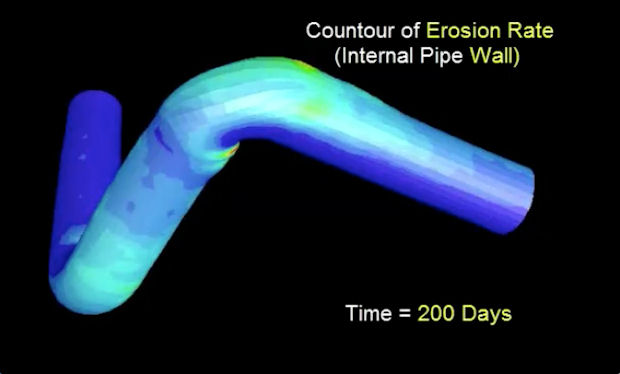Designing High-Reliability Oil and Gas Equipment
Latest News
November 17, 2014
 Dear Desktop Engineering Reader:
Dear Desktop Engineering Reader:
“Designing High-Reliability Oil and Gas Equipment by Minimizing the Impact of Erosion,” the 14th chapter in ANSYS’ Tech Tip series, covers the challenges sand erosion poses and how you can use CFD (computational fluid dynamics) to explore ways of managing them. In particular, the data available on this landing page explores how you can manage the effects of sand erosion inside of the piping used in oil and gas well exploration and transport. The concepts presented seem easily applicable to other industries that work with carrying fluids containing sand and similar proppants.
Sand erosion poses a number of gritty challenges that are costly to manage and monitor. For example, sand entrained in carrying fluids collides with pipe and/or equipment walls, where it dings away bits of material and eventually leads to wear and even premature mechanical failure. Erosion from sand also wears away the protective coatings applied on metals to prevent corrosion.
Analyzing systems for sand erosion wear is a complex process with many factors to consider beyond your flow system’s configuration and the flow rate. You also need to factor in data on the composition and properties of the carrying fluid, loading, the size and shape of entrained solid particles as well as the physical properties of the target material.
ANSYS Fluent CFD software offers a number of technologies that can help you make accurate and robust predictions of sand erosion. Four elements you can draw upon are key to simulating sand erosion in oil and gas and similar applications:
- Validated single-phase and multiphase modeling abilities for any type of oil and gas flow;
- Validated solid-particle flow modeling capabilities for a range of sand particle sizes and loadings;
- An array of industry-accepted erosion models as well as a facility to incorporate your proprietary erosion models;
- The ability to deform the pipe wall if erosion affects the flow pattern.
If you’re reading the HTML version of this message, the top image comes toward the end of the video. You’ll find animated versions of it and a second image below the video on the landing page. Both images show how ANSYS Fluent gives you the ability to study the deformation of a pipe wall in response to the predicted effects of erosion. The image above depicts the changes in the shape of pipe after 200 days of sand erosion. The color-coding of the internal pipe wall indicates eroded thickness. The second animation shows the change in shape of the pipe and the erosion of the pipe material – its thickness – over the same period of time.
A PDF of the “Simulating Erosion Using ANSYS Computational Fluid Dynamics” webinar is the final component of this ANSYS Tech Tip. You’ll find it in a block at the top right corner of your screen. This webinar covers much of the same ground as the short video but with much greater technical detail on the multiphysics, multi-scale and multi-component configurations of particulate flows. It provides details on the erosion models that you can choose from and shows the steps involved in analysis setup. It also has a lot of cool screenshots.
The importance of accurately simulating sand erosion in oil and gas applications to ensure high equipment reliability cannot be overstated. The “Designing High-Reliability Oil and Gas Equipment by Minimizing the Impact of Erosion” ANSYS Tech Tip is an absorbing presentation, even if you’re not worrying about moving abrasive slurries around. For ANSYS Fluent users and anyone involved with sand management and transport in pipelines, it should prove itself an excellent resource. Hit today’s Check it Out link and see for yourself.
Thanks, Pal. – Lockwood
Anthony J. Lockwood
Editor at Large, Desktop Engineering
Go to “Designing High-Reliability Oil and Gas Equipment by Minimizing the Impact of Erosion.”
Subscribe to our FREE magazine, FREE email newsletters or both!
Latest News
About the Author
Anthony J. Lockwood is Digital Engineering’s founding editor. He is now retired. Contact him via [email protected].
Follow DE






